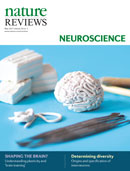|
Advertisement | |||||||||||||||||||||||||||||||||||||||||||||||
| |||||||||||||||||||||||||||||||||||||||||||||||
| TABLE OF CONTENTS | |||||||||||||||||||||||||||||||||||||||||||||||
| May 2017 Volume 18 Number 5 | Advertisement | ||||||||||||||||||||||||||||||||||||||||||||||
| In this issue
|
| |||||||||||||||||||||||||||||||||||||||||||||
| |||||||||||||||||||||||||||||||||||||||||||||||
 | |||||||||||||||||||||||||||||||||||||||||||||||
| Advertisement | |||||||||||||||||||||||||||||||||||||||||||||||
| |||||||||||||||||||||||||||||||||||||||||||||||
| Comment: Towards a stronger science of human plasticity Ulman Lindenberger, Elisabeth Wenger & Martin Lövdén p261 | doi:10.1038/nrn.2017.44 Lindenberger and colleagues suggest that research into the possible effects of 'brain training' should build on an understanding of the mechanisms of human brain plasticity. Full Text | PDF | |||||||||||||||||||||||||||||||||||||||||||||||
| |||||||||||||||||||||||||||||||||||||||||||||||
| Advertisement | |||||||||||||||||||||||||||||||||||||||||||||||
| |||||||||||||||||||||||||||||||||||||||||||||||
| REVIEWS | Top | ||||||||||||||||||||||||||||||||||||||||||||||
| Motor compensation and its effects on neural reorganization after stroke Theresa A. Jones p267 | doi:10.1038/nrn.2017.26 Stroke survivors often adapt to the loss of upper-limb function by adopting compensatory strategies. Jones discusses evidence that these compensatory strategies may influence the neural remodelling processes that occur after the initial stroke and can have mixed effects on functional outcome of the paretic limb. Abstract | Full Text | PDF | |||||||||||||||||||||||||||||||||||||||||||||||
| Not just amyloid: physiological functions of the amyloid precursor protein family Ulrike C. Müller, Thomas Deller & Martin Korte p281 | doi:10.1038/nrn.2017.29 Amyloid precursor protein (APP) has been heavily implicated in Alzheimer disease, but the physiological roles of APP and the related APP-like proteins (APLPs) remain less well understood. This Review examines the functions of the APP family and its fragments in CNS development, synaptic function, brain injury and ageing. Abstract | Full Text | PDF | Supplementary information | |||||||||||||||||||||||||||||||||||||||||||||||
| Genetic and activity-dependent mechanisms underlying interneuron diversity Brie Wamsley & Gord Fishell p299 | doi:10.1038/nrn.2017.30 Our growing understanding of cortical interneuron diversity has been matched by increasing interest in the underlying developmental mechanisms. Wamsley and Fishell describe current models of interneuron specification, highlighting the contribution of activity-dependent mechanisms to this process. Abstract | Full Text | PDF | |||||||||||||||||||||||||||||||||||||||||||||||
| PERSPECTIVES | Top | ||||||||||||||||||||||||||||||||||||||||||||||
| OPINION Algorithms for survival: a comparative perspective on emotions Dominik R. Bach & Peter Dayan p311 | doi:10.1038/nrn.2017.35 There is little agreement on the definition of emotions or the neural mechanisms by which they are realized. Bach and Dayan here use decision theory to shed light on the nature and implementation of the algorithms that underlie emotion-related behaviours. Abstract | Full Text | PDF | |||||||||||||||||||||||||||||||||||||||||||||||
| |||||||||||||||||||||||||||||||||||||||||||||||
You have been sent this Table of Contents Alert because you have opted in to receive it. You can change or discontinue your e-mail alerts at any time, by modifying your preferences on your nature.com account at: www.nature.com/myaccount For further technical assistance, please contact our registration department For print subscription enquiries, please contact our subscription department For other enquiries, please contact our feedback department Nature Publishing Group | One New York Plaza, Suite 4500 | New York | NY 10004-1562 | USA Nature Publishing Group's worldwide offices: Macmillan Publishers Limited is a company incorporated in England and Wales under company number 785998 and whose registered office is located at The Campus, 4 Crinan Street, London, N1 9XW. © 2017 Nature Publishing Group, a division of Macmillan Publishers Limited. All Rights Reserved. |
 |









1 comment:
My grandma had Parkinson's disease, she is about 80 years old it was detected 7 years ago. it was getting more difficult to live for her, because of stiff muscles she can't even move. L-dopa and carbidopa medicines are given, but won"t give much relief. She can"t eat food and the skin is damaging forming ganglia. This is may be the last stage of disease.. nothing was really working to help her condition. Finally she started on parkinson's herbal formula i purchased from Health Herbal Clinic, i read alot of positive reviews from other patients who used the parkinson's herbal treatment. she used the herbal remedy for 7 weeks, its effects on parkinson's is amazing, all her symptoms gradually faded away, she feed very more freely by herself now! (Visit www. healthherbalclinic. weebly. com or email at healthherbalclinic@ gmail. com) I recommend this Parkinson's herbal formula for all Parkinson's Patients.
Post a Comment